Mother’s Day is fast approaching and I’m sure you’ll be treating Mom to a feast fit for a Queen! If you’re looking for the perfect wine pairing for your festivities here’s 5 Fabulous Wine Recommendations from some of our favorite “Women of the Vine”:
 GIFFT Pinot Noir Rosé, Monterey, California, 2014 ($16): This wine is the newest addition to Kathie Lee Gifford’s GIFFT line of wines created in partnership with Scheid Vineyards (for more information, please click here). This delightful dry rosé is crafted from 100% estate grown Pinot Noir from the Scheid family’s Mesa del Rio vineyard in Monterey, California, a region known for producing beautiful Chardonnay and Pinot Noir. The grapes were fermented entirely in stainless steel to preserve the fresh, fruity flavors of watermelon, strawberry, and raspberry. A crisp, food-friendly acidity and lengthy finish will keep you coming back for more.
GIFFT Pinot Noir Rosé, Monterey, California, 2014 ($16): This wine is the newest addition to Kathie Lee Gifford’s GIFFT line of wines created in partnership with Scheid Vineyards (for more information, please click here). This delightful dry rosé is crafted from 100% estate grown Pinot Noir from the Scheid family’s Mesa del Rio vineyard in Monterey, California, a region known for producing beautiful Chardonnay and Pinot Noir. The grapes were fermented entirely in stainless steel to preserve the fresh, fruity flavors of watermelon, strawberry, and raspberry. A crisp, food-friendly acidity and lengthy finish will keep you coming back for more.
 Elena Walch Pinot Grigio Castel Ringberg, Alto Adige, Italy, 2013 ($22): Elena Walch is a leading wine producer in the Alto Adige region of northeastern Italy. She runs her eponymous winery with the help of her two daughters, Julia and Karoline, and together they produce an array of acclaimed wines. This wine is 100% Pinot Grigio from the Castel Ringberg vineyard. 85% is fermented in stainless steel while the remainder is fermented in used French oak barriques. The result is a lovely incarnation of this grape with ripe aromas of pear, sage and spice with a creamy mouthfeel, zippy acidity and lengthy, clean finish.
Elena Walch Pinot Grigio Castel Ringberg, Alto Adige, Italy, 2013 ($22): Elena Walch is a leading wine producer in the Alto Adige region of northeastern Italy. She runs her eponymous winery with the help of her two daughters, Julia and Karoline, and together they produce an array of acclaimed wines. This wine is 100% Pinot Grigio from the Castel Ringberg vineyard. 85% is fermented in stainless steel while the remainder is fermented in used French oak barriques. The result is a lovely incarnation of this grape with ripe aromas of pear, sage and spice with a creamy mouthfeel, zippy acidity and lengthy, clean finish.
 Domaine Drouhin Pinot Noir, Dundee Hills Valley, Oregon, 2012 ($44): Maison Joseph Drouhin was established in Burgundy, France in 1880 and the family expanded to Oregon in the late 1980’s upon realizing the potential of the Willamette Valley to produce world class Chardonnay and Pinot Noir. Véronique Boss-Drouhin is the family’s fourth generation winemaker and is responsible for crafting the family’s wines from both Burgundy and Oregon terroirs. This Pinot Noir is a lovely example of her expertise with enticing notes of violet, earth, pomegranate and cherry pie with supple tannins and a deliciously lengthy finish.
Domaine Drouhin Pinot Noir, Dundee Hills Valley, Oregon, 2012 ($44): Maison Joseph Drouhin was established in Burgundy, France in 1880 and the family expanded to Oregon in the late 1980’s upon realizing the potential of the Willamette Valley to produce world class Chardonnay and Pinot Noir. Véronique Boss-Drouhin is the family’s fourth generation winemaker and is responsible for crafting the family’s wines from both Burgundy and Oregon terroirs. This Pinot Noir is a lovely example of her expertise with enticing notes of violet, earth, pomegranate and cherry pie with supple tannins and a deliciously lengthy finish.
 Hall Cabernet Sauvignon, Napa Valley, California, 2011 ($48): Kathryn Hall is the proprietress of Hall Winery and has been involved in the California wine industry since her family first purchased a vineyard there over thirty years ago. Known for her eponymous Cabernets, this wine is a blend of 97% Cabernet Sauvignon, 2% Petit Verdot and 1% Cabernet Franc which spent 20 months in 55% new French oak. The resulting wine has delicious notes of red currant, plum, tobacco, mocha and spice and is the perfect choice for Moms who crave big, bold reds with oodles of tannin.
Hall Cabernet Sauvignon, Napa Valley, California, 2011 ($48): Kathryn Hall is the proprietress of Hall Winery and has been involved in the California wine industry since her family first purchased a vineyard there over thirty years ago. Known for her eponymous Cabernets, this wine is a blend of 97% Cabernet Sauvignon, 2% Petit Verdot and 1% Cabernet Franc which spent 20 months in 55% new French oak. The resulting wine has delicious notes of red currant, plum, tobacco, mocha and spice and is the perfect choice for Moms who crave big, bold reds with oodles of tannin.
 Veuve Clicquot Demi-Sec Champagne, France, NV ($70): Barbe Nicole Clicquot Ponsardin (aka Veuve Clicquot or Widow Clicquot) assumed the reigns of her husband’s Champagne House in 1805 at the age of 27. Her contributions to Champagne were many including this delicious Demi-Sec, which is slightly sweeter than your standard Brut Champagne, but balanced by an elegant acidity. This blend of all three Champagne grape varieties (Chardonnay, Pinot Noir and Pinot Meunier) exhibits notes of peach, honey and toasted brioche which will make the perfect accompaniment to a lighter, fruit-based dessert.
Veuve Clicquot Demi-Sec Champagne, France, NV ($70): Barbe Nicole Clicquot Ponsardin (aka Veuve Clicquot or Widow Clicquot) assumed the reigns of her husband’s Champagne House in 1805 at the age of 27. Her contributions to Champagne were many including this delicious Demi-Sec, which is slightly sweeter than your standard Brut Champagne, but balanced by an elegant acidity. This blend of all three Champagne grape varieties (Chardonnay, Pinot Noir and Pinot Meunier) exhibits notes of peach, honey and toasted brioche which will make the perfect accompaniment to a lighter, fruit-based dessert.
Please join us this Thursday, May 7th for our Mother’s Day Wine Tasting featuring Kathie Lee Gifford’s GIFFT Wines at Linen Closet in downtown Delray Beach. Come sip, sample and shop with us and for more information, please click here. I’d also like to wish all you fabulous Moms out there a very Happy Mother’s Day!
Cheers,
Don your beret and grab a glass of Chablis, my fellow wine lovers – it’s time for a little French lesson for our latest Wine Word of the Week! Bâtonnage (bat-un-AJH) is a French term which refers to the stirring of a wine which is being fermented sur lie, or “on the lees.” Lees refers to the dead yeast cells... Read More
The post Wine Word of the Week: Bâtonnage! appeared first on The Glamorous Gourmet.
Don your beret and grab a glass of Chablis, my fellow wine lovers – it’s time for a little French lesson for our latest Wine Word of the Week!
Bâtonnage (bat-un-AJH) is a French term which refers to the stirring of a wine which is being fermented sur lie, or “on the lees.” Lees refers to the dead yeast cells and other matter which collects at the bottom of the barrel as a normal byproduct of fermentation. Allowing the wine to remain in contact with these cells imparts a fuller, richer body and more complexity to the wine. Stirring or bâtonnage facilitates this process by maximizing the wine’s exposure to the lees. The extent to which this technique is employed is determined by the winemaker and the style of wine he or she is trying to produce. The more contact the wine has with the dead yeast cells, the more effect it will have on the wine.
Because they are intrinsically linked, you will usually see the terms “sur lie” and “bâtonnage” used together. These techniques are best known for their role in producing white wines such as White Burgundy as well as New World incarnations of the Chardonnay grape.
I hope you enjoyed our latest Wine Word of the Week, to view previous installments of this segment please click here. If you have a wine word you’d like to learn more about, please tell us in the comment section below – thanks for stopping by!
Cheers,
The flowers are blooming, the birds are chirping and sunny days are steadily replacing the gloom of winter. Spring is upon us and one of my favorite wines to enjoy this time of year is Chablis. These wines should not be confused with the low quality, jug wine made infamous in the 1970's. In fact, quite the contrary, authentic Chablis is all about freshness, elegance and purity.Chablis is the northernmost wine district of Burgundy, one of France's most acclaimed wine regions. This is undeniably white wine country and Chablis' signature grape is Chardonnay. Unlike Chardonnay produced in warmer climates such as California, Burgundy's cool climate produces wines which are light and lemony, and known more for their lively acidity and minerality than opulent fruit and spice. These wines are perfect for sipping on a bright, sunny Spring day or paired with a wide variety of cuisines.I recently had the pleasure of attending a Chablis tasting in Miami at La Mar by Gastón Acurio located in the tony Mandarin Oriental Hotel. This chic Peruvian eatery strategically overlooks both the beautiful Biscayne Bay and dramatic Miami skyline. Since it was a beautiful sunny South Florida day, we enjoyed our tasting al fresco, guided by our charming host, Jean François Bordet, President of the Chablis Wine Board and proprietor of Domaine Séguinot-Bordet, his family's winery founded in 1590.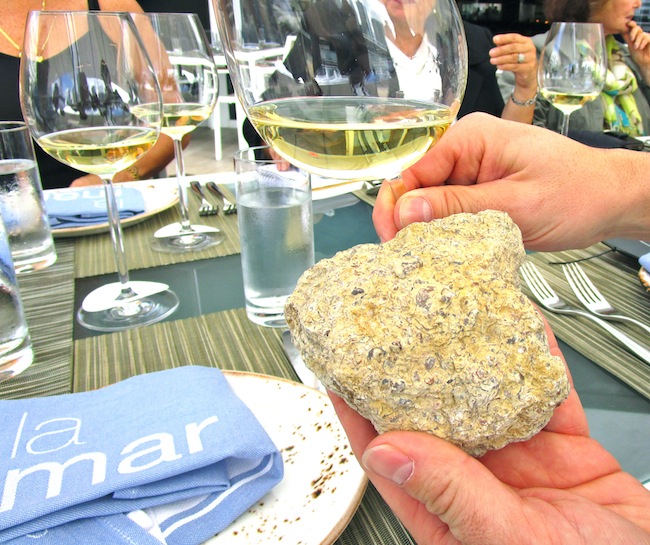 Our tasting involved a selection of wines from three of Chablis' four appellations which are: Petit Chablis, Chablis, Chablis Premier Cru and Chablis Grand Cru. When sampling Burgundian wine, the concept of terroir is always at the forefront (for more information on "terroir" please click here).Terroir essentially refers to the intersection of soil, grape variety, climate and winemaker influence and how these factors come together to create a wine that is unique to a specific place which cannot be produced anywhere else in the world. Key to this theory are Climats, or designated plots of land with specific geological and climatic conditions, which impart their own unique impression on wine.
Our tasting involved a selection of wines from three of Chablis' four appellations which are: Petit Chablis, Chablis, Chablis Premier Cru and Chablis Grand Cru. When sampling Burgundian wine, the concept of terroir is always at the forefront (for more information on "terroir" please click here).Terroir essentially refers to the intersection of soil, grape variety, climate and winemaker influence and how these factors come together to create a wine that is unique to a specific place which cannot be produced anywhere else in the world. Key to this theory are Climats, or designated plots of land with specific geological and climatic conditions, which impart their own unique impression on wine.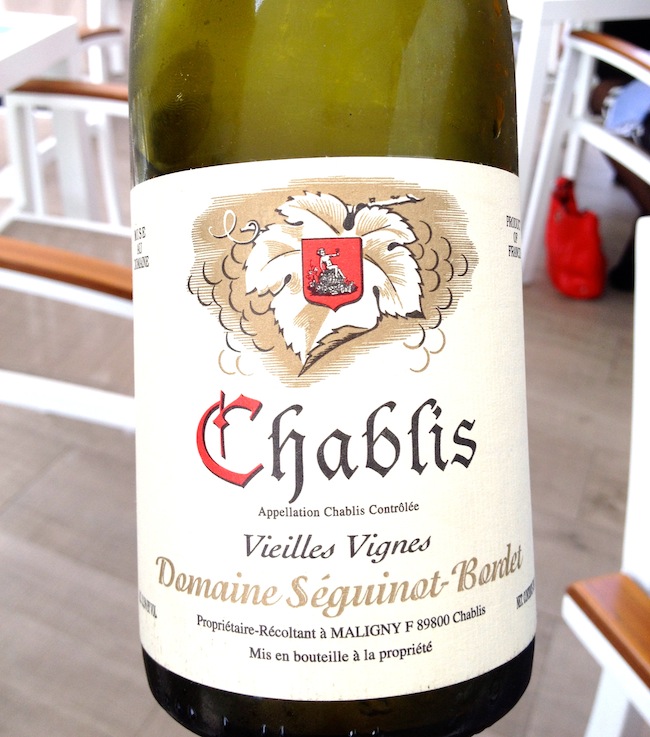 The soils of Chablis are legendary for their limestone content and were formed long ago in the Kimmeridgian period (Upper Jurassic era). This unique soil contains millions of fossils of oysters and other marine creatures and is primarily found in the Chablis and Premier Cru appellations.Petit Chablis, on the other hand, is situated on soils formed more recently, which contain limestone from the Portlandian period. The Chablis Grand Cru vines grow on steep slopes rife with Kimmeridgian limestone as well as an extremely rich subsoil.
The soils of Chablis are legendary for their limestone content and were formed long ago in the Kimmeridgian period (Upper Jurassic era). This unique soil contains millions of fossils of oysters and other marine creatures and is primarily found in the Chablis and Premier Cru appellations.Petit Chablis, on the other hand, is situated on soils formed more recently, which contain limestone from the Portlandian period. The Chablis Grand Cru vines grow on steep slopes rife with Kimmeridgian limestone as well as an extremely rich subsoil.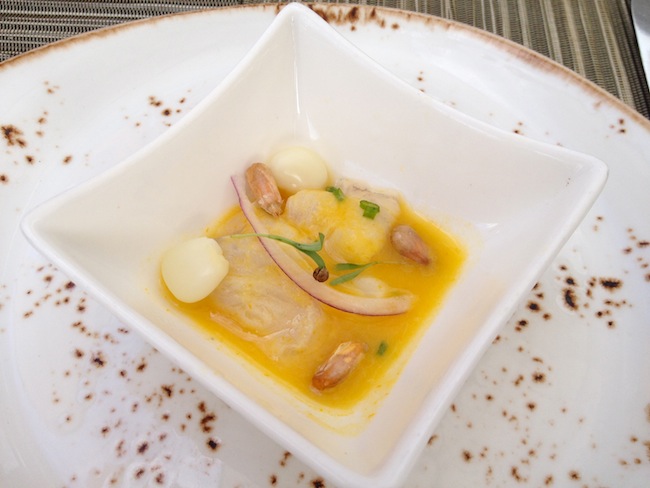 Our tasting featured a selection of wines which beautifully represented their respective appellations. Chef Acurio prepared an assortment of delicious dishes to pair with each group of wines which were served in three consecutive flights.Our first flight featured one wine, the 2013 Domaine Séguinot-Bordet Chablis Vieilles Vignes. Vieilles Vignes means "old vines" which, in this case, are 78 years old and located on the family's 40 acre estate in Maligny. The wine was fermented in oak barrels (15% new) and stainless steel (85%) resulting in a fresh, lively wine that was a classic example of the region!The wine paired beautifully with Chef's dishes which included Cebiche Nikei with tuna, red onion, nori, avocado, daikon cucumber, and tamarind leche de tigre; Causa Congrejo featuring beet causa, crab, avocado, huancaina sauce, fried kale, cherry tomatoes and quail egg; and a perennial favorite, Empanadas with pork adobo and pepian de choclo, chalaca, and huacatay sauce. Chef Acurio's dishes were as much a feast for the eyes as the palate and the wine definitely held it's own amidst the onslaught of deliciousness. It's hallmark acidity tempered the richness and variety of textures while also allowing the flavors of the food to shine through.
Our tasting featured a selection of wines which beautifully represented their respective appellations. Chef Acurio prepared an assortment of delicious dishes to pair with each group of wines which were served in three consecutive flights.Our first flight featured one wine, the 2013 Domaine Séguinot-Bordet Chablis Vieilles Vignes. Vieilles Vignes means "old vines" which, in this case, are 78 years old and located on the family's 40 acre estate in Maligny. The wine was fermented in oak barrels (15% new) and stainless steel (85%) resulting in a fresh, lively wine that was a classic example of the region!The wine paired beautifully with Chef's dishes which included Cebiche Nikei with tuna, red onion, nori, avocado, daikon cucumber, and tamarind leche de tigre; Causa Congrejo featuring beet causa, crab, avocado, huancaina sauce, fried kale, cherry tomatoes and quail egg; and a perennial favorite, Empanadas with pork adobo and pepian de choclo, chalaca, and huacatay sauce. Chef Acurio's dishes were as much a feast for the eyes as the palate and the wine definitely held it's own amidst the onslaught of deliciousness. It's hallmark acidity tempered the richness and variety of textures while also allowing the flavors of the food to shine through.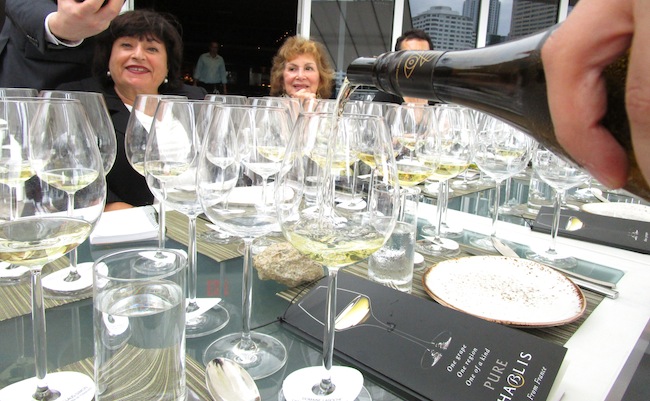 The second course featured three Chablis offerings from the Premier Cru appellation which is comprised of 40 individual Climats, 17 of which are most prominent.These wines generally exhibit more complexity and structure than basic Chablis and have good aging potential as well, approximately 5 to 10 years. The words "Premier Cru" and the name of the Climat of origin may be added to the name Chablis on the wine's label.
The second course featured three Chablis offerings from the Premier Cru appellation which is comprised of 40 individual Climats, 17 of which are most prominent.These wines generally exhibit more complexity and structure than basic Chablis and have good aging potential as well, approximately 5 to 10 years. The words "Premier Cru" and the name of the Climat of origin may be added to the name Chablis on the wine's label.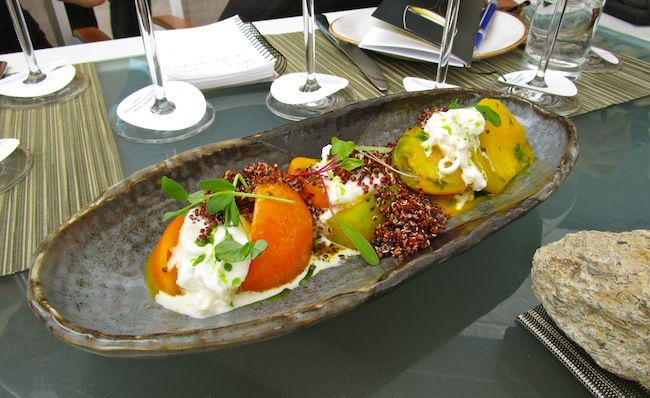 The three wines in our second flight included the 2011 Maison Simonnet Febvre Chablis 1er Cru Vaillons; 2011 Domaine Billaud-Simon Chablis 1er Cru Montée de Tonnerre; and the 2009 Domaine Oudin Chablis 1er Cru Vaugiraut. This collection of wines provided an insightful snapshot of the Premier Cru appellation.The Simmonet Febvre Vaillons had notes of white peach and citrus with a clean, racy acidity and lengthy finish; the Billaud-Simon Montée de Tonnerre was a study in elegance with floral and mineral aromas accompanied by vibrant citrus, limestone and gunflint; the Domaine Oudin Vaugiraut was slightly older than the two other wines and had a slight oxidative quality in addition to notes of gunflint, minerality and citrus.Chef Acurio's Quinoa Caprese was beautifully colorful with heirloom tomatoes, basil, red quinoa, burrata cheese with an aji amarillo vinaigrette which paired best with the Domain Oudin Vaugiraut. The Seared Scallop Conchitas with lomo saltado sauce, garlic chips and crispy sweet potato strings paired brilliantly with the other two wines.
The three wines in our second flight included the 2011 Maison Simonnet Febvre Chablis 1er Cru Vaillons; 2011 Domaine Billaud-Simon Chablis 1er Cru Montée de Tonnerre; and the 2009 Domaine Oudin Chablis 1er Cru Vaugiraut. This collection of wines provided an insightful snapshot of the Premier Cru appellation.The Simmonet Febvre Vaillons had notes of white peach and citrus with a clean, racy acidity and lengthy finish; the Billaud-Simon Montée de Tonnerre was a study in elegance with floral and mineral aromas accompanied by vibrant citrus, limestone and gunflint; the Domaine Oudin Vaugiraut was slightly older than the two other wines and had a slight oxidative quality in addition to notes of gunflint, minerality and citrus.Chef Acurio's Quinoa Caprese was beautifully colorful with heirloom tomatoes, basil, red quinoa, burrata cheese with an aji amarillo vinaigrette which paired best with the Domain Oudin Vaugiraut. The Seared Scallop Conchitas with lomo saltado sauce, garlic chips and crispy sweet potato strings paired brilliantly with the other two wines.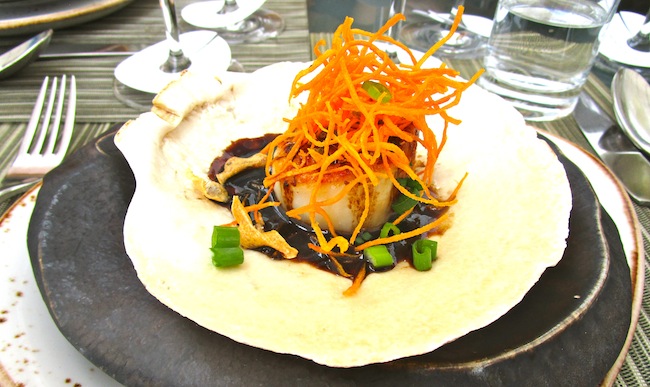 The third course featured two wines from Chablis' Grand Cru appellation which consists of seven Climats: Blanchot, Bougros, Les Clos, Grenouilles, Preuses, Valmur and Vaudésir.These wines represent the jewel in the crown of the Chablis region. They also have the most aging potential (usually around 7-10 years), a more generous mouthfeel, lengthier finish and more complexity which is usually manifested in notes of spice, honey, almond and dried fruit.
The third course featured two wines from Chablis' Grand Cru appellation which consists of seven Climats: Blanchot, Bougros, Les Clos, Grenouilles, Preuses, Valmur and Vaudésir.These wines represent the jewel in the crown of the Chablis region. They also have the most aging potential (usually around 7-10 years), a more generous mouthfeel, lengthier finish and more complexity which is usually manifested in notes of spice, honey, almond and dried fruit.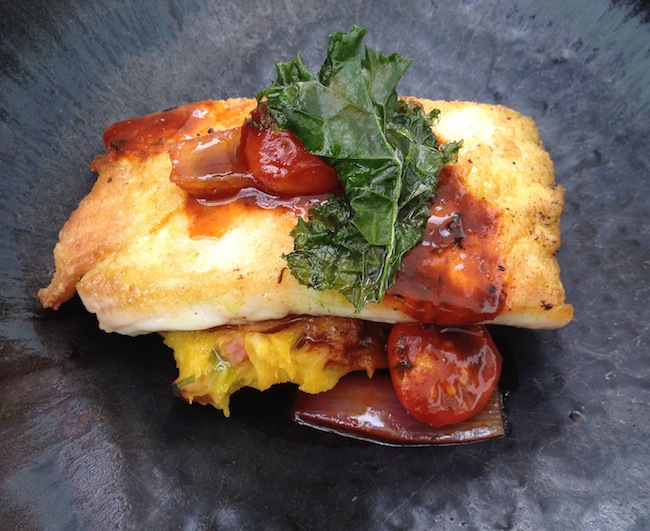
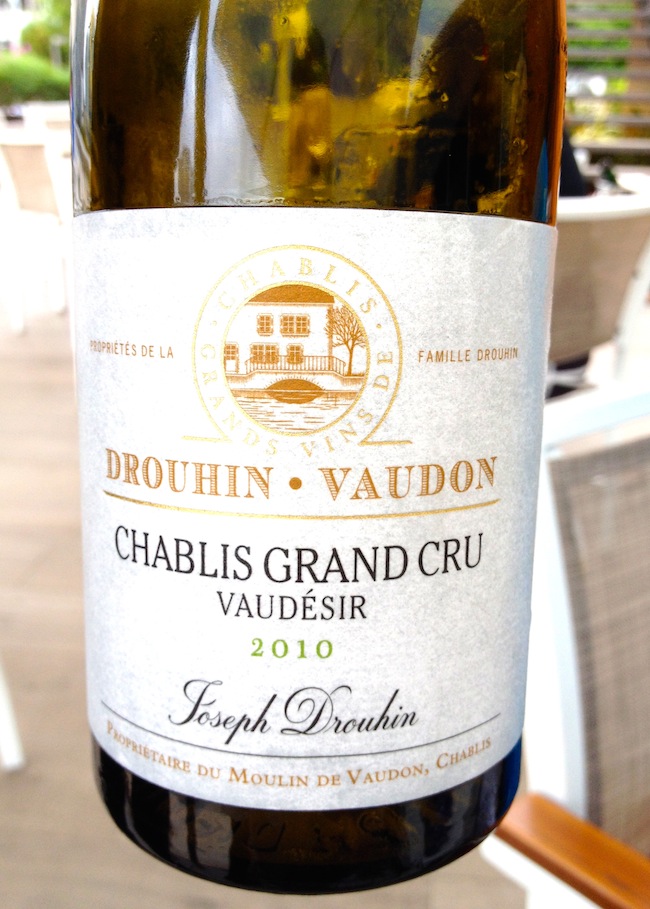 The two Grand Cru wines featured in our third course were the 2010 Maison Drouhin Vaudon Chablis Grand Cru Vaudésir and the 2009 Domaine Laroche Chablis Grand Cru Blanchot.The Drouhin Vaudon Vaudésir, served en magnum, is a product of thirty year old vines whose grapes were manually harvested and gently pressed to preserve the quality of the fruit. The wine was then fermented entirely in French oak (0% new) for 12 months and the resulting wine offered a complex array peach, honey, spice and almond with a lengthy, mineral-tinged finish. This nuanced wine had a rich texture yet was also was bright and lively with plenty of finesse - a beautiful effort!The Domaine Laroche Blanchot, a product of 45 year old vines, was also manually harvested and fermented partially in stainless steel (60%) while the remainder went into French oak barrels (15% new) for 14 months. The resulting wine was also lovely and layered with notes of peach, apple, limestone and honey which continued to evolve in the glass over our third course. To enjoy with our Grand Cru Chablis, Chef Acurio prepared a mouth watering Amazon fish with tamarind chorillana sauce, yucca and smoked bacon - a truly divine pairing!
The two Grand Cru wines featured in our third course were the 2010 Maison Drouhin Vaudon Chablis Grand Cru Vaudésir and the 2009 Domaine Laroche Chablis Grand Cru Blanchot.The Drouhin Vaudon Vaudésir, served en magnum, is a product of thirty year old vines whose grapes were manually harvested and gently pressed to preserve the quality of the fruit. The wine was then fermented entirely in French oak (0% new) for 12 months and the resulting wine offered a complex array peach, honey, spice and almond with a lengthy, mineral-tinged finish. This nuanced wine had a rich texture yet was also was bright and lively with plenty of finesse - a beautiful effort!The Domaine Laroche Blanchot, a product of 45 year old vines, was also manually harvested and fermented partially in stainless steel (60%) while the remainder went into French oak barrels (15% new) for 14 months. The resulting wine was also lovely and layered with notes of peach, apple, limestone and honey which continued to evolve in the glass over our third course. To enjoy with our Grand Cru Chablis, Chef Acurio prepared a mouth watering Amazon fish with tamarind chorillana sauce, yucca and smoked bacon - a truly divine pairing!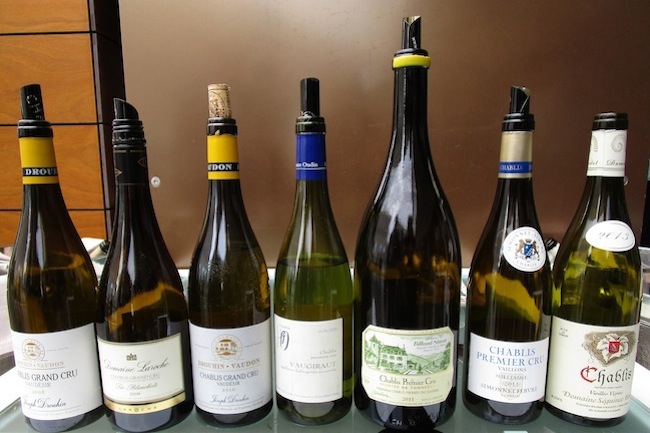 I hope after reading this post you also feel inspired to explore the delightful wines of Chablis this Spring! And for more information on the Chablis region, please go ahead and click here.Cheers,
I hope after reading this post you also feel inspired to explore the delightful wines of Chablis this Spring! And for more information on the Chablis region, please go ahead and click here.Cheers,
The flowers are blooming, the birds are chirping and sunny days are steadily replacing the gloom of winter. Spring is upon us and one of my favorite wines to enjoy this time of year is Chablis. These wines should not be confused with the low quality, jug wine made infamous in the 1970’s. In fact, quite the contrary, authentic Chablis... Read More
The post Wines of the Week: Spring is the Perfect Time for Chablis! appeared first on The Glamorous Gourmet.
The flowers are blooming, the birds are chirping and sunny days are steadily replacing the gloom of winter. Spring is upon us and one of my favorite wines to enjoy this time of year is Chablis. These wines should not be confused with the low quality, jug wine made infamous in the 1970’s. In fact, quite the contrary, authentic Chablis is all about freshness, elegance and purity.
Chablis is the northernmost wine district of Burgundy, one of France’s most acclaimed wine regions. This is undeniably white wine country and Chablis’ signature grape is Chardonnay. Unlike Chardonnay produced in warmer climates such as California, Burgundy’s cool climate produces wines which are light and lemony, and known more for their lively acidity and minerality than opulent fruit and spice. These wines are perfect for sipping on a bright, sunny Spring day or paired with a wide variety of cuisines.
I recently had the pleasure of attending a Chablis tasting in Miami at La Mar by Gastón Acurio located in the tony Mandarin Oriental Hotel. This chic Peruvian eatery strategically overlooks both the beautiful Biscayne Bay and dramatic Miami skyline. Since it was a beautiful sunny South Florida day, we enjoyed our tasting al fresco, guided by our charming host, Jean François Bordet, President of the Chablis Wine Board and proprietor of Domaine Séguinot-Bordet, his family’s winery founded in 1590.
Our tasting involved a selection of wines from three of Chablis’ four appellations which are: Petit Chablis, Chablis, Chablis Premier Cru and Chablis Grand Cru. When sampling Burgundian wine, the concept of terroir is always at the forefront (for more information on “terroir” please click here). Terroir essentially refers to the intersection of soil, grape variety, climate and winemaker influence and how these factors come together to create wine that is unique to a specific place which cannot be produced anywhere else in the world. Key to this theory are Climats, or designated plots of land with specific geological and climatic conditions, which impart their own unique impression on wine.
The soils of Chablis are legendary for their limestone content and were formed long ago in the Kimmeridgian period (Upper Jurassic era). This unique soil contains millions of fossils of oysters and other marine creatures and is primarily found in the Chablis and Chablis Premier Cru appellations. Petit Chablis is situated on soils formed more recently, which contain limestone from the Portlandian period. The Chablis Grand Cru vines grow on steep slopes rife with Kimmeridgian limestone as well as an extremely rich subsoil.
Our tasting featured a selection of wines which beautifully represented their respective appellations. Chef Acurio prepared an assortment of delicious dishes to pair with each group of wines which were served in three consecutive flights.
Our first flight featured one wine, the 2013 Domaine Séguinot-Bordet Chablis Vieilles Vignes. Vieilles Vignes means “old vines” which, in this case, are 78 years old and located on the family’s 40 acre estate in Maligny. The wine was fermented in oak barrels (15% new) and stainless steel (85%) resulting in a fresh, lively wine that was classic Chablis! It paired beautifully with Chef’s dishes which included Cebiche Nikei with tuna, red onion, nori, avocado, daikon cucumber, and tamarind leche de tigre; Causa Congrejo featuring beet causa, crab, avocado, huancaina sauce, fried kale, cherry tomatoes and quail egg; and a perennial favorite, Empanadas with pork adobo and pepian de choclo, chalaca, and huacatay sauce. Chef Acurio’s dishes were as much a feast for the eyes as the palate and the wine definitely held it’s own amidst the onslaught of deliciousness. It’s hallmark acidity tempered the richness and variety of textures while also allowing the flavors of the food to shine through.
The second course featured three Chablis offerings from the Premier Cru appellation which is comprised of 40 individual Climats, 17 of which are most prominent. These wines generally exhibit more complexity and structure than basic Chablis and have good aging potential as well, approximately 5 to 10 years. The words “Premier Cru” and the name of the Climat of origin may be added to the name Chablis on the wine’s label.
The three wines in our second flight included the 2011 Maison Simonnet Febvre Chablis 1er Cru Vaillons; 2011 Domaine Billaud-Simon Chablis 1er Cru Montée de Tonnerre; and the 2009 Domaine Oudin Chablis 1er Cru Vaugiraut. This collection of wines provided an insightful snapshot of the Premier Cru appellation. The Simmonet Febvre Vaillons had notes of white peach and citrus with a clean, racy acidity and lengthy finish; the Billaud-Simon Montée de Tonnerre was a study in elegance with floral and mineral aromas accompanied by vibrant citrus, limestone and gunflint; the Domaine Oudin Vaugiraut was slightly older than the two other wines and had a slight oxidative quality in addition to notes of gunflint, minerality and citrus. Chef Acurio’s Quinoa Caprese was beautifully colorful with heirloom tomatoes, basil, red quinoa, burrata cheese with an aji amarillo vinaigrette which paired best with the Domain Oudin Vaugiraut. The Seared Scallop Conchitas with lomo saltado sauce, garlic chips and crispy sweet potato strings paired brilliantly with the other two wines.
The third course featured two wines from Chablis’ Grand Cru appellation which consists of seven Climats: Blanchot, Bougros, Les Clos, Grenouilles, Preuses, Valmur and Vaudésir. These wines represent the jewel in the crown of the Chablis region. They also have the most aging potential (usually around 7-10 years), a more generous mouthfeel, lengthier finish and more complexity which is usually manifested in notes of spice, honey, almond and dried fruit.
Our third flight consisted of two Grand Cru wines, the 2010 Maison Drouhin Vaudon Chablis Grand Cru Vaudésir and the 2009 Domaine Laroche Chablis Grand Cru Blanchot. The Drouhin Vaudon Vaudésir, served en magnum, is a product of thirty year old vines whose grapes were manually harvested and gently pressed to preserve the quality of the fruit. The wine was fermented entirely in oak (0% new) for 12 months and the resulting wine offered a complex array peach, honey, spice and almond with a lengthy, mineral-tinged finish. This nuanced wine had a rich texture yet was also was bright and lively with plenty of finesse – a beautiful effort! The Domaine Laroche Blanchot, a product of 45 year old vines, was also manually harvested and fermented partially in stainless steel (60%) while the remainder went into French oak barrels (15% new) for 14 months. The resulting wine was also lovely and layered with notes of peach, apple, limestone and honey which continued to evolve in the glass over our third course. To enjoy with our Grand Cru Chablis, Chef Acurio prepared a mouth watering Amazon fish with tamarind chorillana sauce, yucca and smoked bacon – a truly divine pairing!
 I hope you feel inspired to explore the wines of this very special region this Spring! For more information on the Chablis region, please click here. For pricing information or to purchase any of the wines mentioned in this post, please click here to go to the Wine Atelier.
I hope you feel inspired to explore the wines of this very special region this Spring! For more information on the Chablis region, please click here. For pricing information or to purchase any of the wines mentioned in this post, please click here to go to the Wine Atelier.
Cheers,
Wine has long been a part of Kathie Lee Gifford's life, and perhaps, now more than ever. Since becoming co-host of the über-popular 4th hour of the Today Show eight years ago, Gifford and co-host Hoda Kotb have become legendary for their on-air imbibing ("we really don't drink all that wine!") as they dish about celebrities, fashion, "favorite things" and pop culture. While Gifford has already achieved legendary status for her roles as TV host, actress, spokesperson, author, playwright, singer and songwriter, this always inspiring and ever creative lady has recently added "vintner" to her lengthy list of credentials.The GIFFT wines were created through Gifford's partnership with Scheid Family Wines of Monterey, California. The family's eponymous winery was established in 1972 and presently consists of 4,200 acres of estate vineyards. The GIFFT name is derived from Gifford's last name combined with her steadfast belief that friendship, love and laughter are gifts to be cherished. She freely admits, "I'm not a wine expert but I know what I like!" and her primary goal was to create a line of delicious, quality wines at an affordable price. The proof, my friends, is in the bottle! The GIFFT portfolio currently consists of a 2012 Estate Grown Chardonnay and a Merlot-dominated 2011 Red Blend which includes 10 different grape varieties. A Rosé of Pinot Noir will be released later this Spring and made its debut alongside the rest of the GIFFT wines last weekend at the 2015 Boca Bacchanal, a food and wine extravaganza which benefits the Boca Raton Historical Society.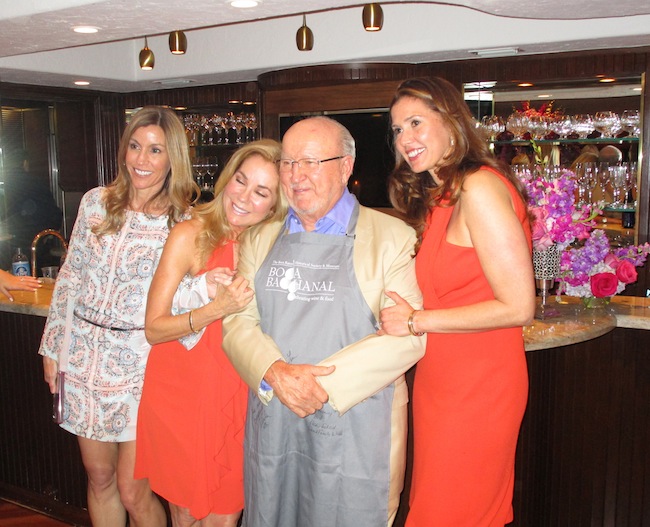 At Saturday night's Vintner Dinner, held at the home of philanthropists Bobby and Barbara Campbell in Boca Raton, the GIFFT/Scheid wines were expertly paired with the cuisine of featured Chef Darek Tidwell of George's at Alys Beach. Gifford was in attendance along with winery Senior Vice President, Heidi Scheid to promote her wines to lucky revelers. During her stay in Boca, I had the opportunity to speak with Gifford about the inception of her wines as well as her longtime love of Florida:GG: Has wine always been a part of your life?KLG: My father was part of Eisenhower's staff so we lived in Post-WWII Paris and some of my sweetest memories growing up were of family meals in France and then later Germany. Dinner usually involved wine and my father would always say, "You don't drink wine, you sip it!" He really savored his meals and took forever to eat but wine was a big part of the culture there.GG: How did you end up partnering with Scheid Family Winery?KLG: Our longtime friend Andy Cohan said to me, "You need to be in the wine business and I know the perfect partner!" And I said, "Where have you been all my life?" So we met the Scheid family and visited their wonderful boutique winery where they've been making phenomenal wine for over 40 years. They farm 4,200 acres and all their wines are estate grown, estate harvested and estate everything! The quality was excellent which was very important to me because I can't sell something I don't believe in.GG: Did you know what type of wine you wanted to make?KLG: I've always been a fan of Chardonnay, the way it was in the mid-1970's, smooth, crisp and fresh, but I had stopped drinking it because it had gotten too heavy, too oaky and it didn't pair well with food anymore. I had even switched to drinking Pinot Grigio so when it came to our wines, I explained to the Scheids I wanted to make a Chardonnay that was light and delicate without being sweet, as well as a red wine that was smooth, luscious and easy drinking.GG: Were you very involved in the process of making and selecting the wines?KLG: Yes and it's been so much fun - we were just out for harvest in September! Initially, my friend Christine and I went out to sample the wines and [the Scheids] had 5 whites and 5 reds for us to try. She loves red wine and I love white so we agreed that she would pick her favorite red and I would pick my favorite white. As luck would have it, she loved the white I chose and I loved the red she chose which just so happened to be the Scheids' favorites too! These wines are also bicoastal, they're made in Monterey, California and we live in Connecticut on the Long Island sound and our favorite place to entertain is our gazebo which is pictured on the label.GG: Are there any particular dishes you recommend to pair with your wines?KLG: I published a book last year called "Good Gifts: One Year in the Heart of a Home," which is a celebration of love, life, laughter, food and faith. We used our stylists from the show, Andy and Elvia, and it's a beautiful book which features alot of our favorite family recipes and also celebrates God's abundance. With our GIFFT Chardonnay I really love Andy's Frutti de Mare (recipe below) or the Chilean Sea Bass with Orange Marmalade Sauce; and with our Red Blend I like Joanie's Spaghetti or the Grilled Salmon Fillet with Sun Dried Tomato Topping.GG: You and your family spend alot of time in Florida, what is it about our state that drew you and your family here?KLG: When I was a spokesperson for Carnival Cruise Line twenty years ago we were spending alot of time in Miami. While we loved it, we really needed a place to get away from the paparazzi and we eventually discovered the Ocean Reef Club. It was so down to earth, family friendly and not snobby at all and we just fell in love with it. We hang out at places like Alabama Jack's which is so laid back and they even serve the GIFFT wines now! It's so much fun to watch people taste our wines there.
At Saturday night's Vintner Dinner, held at the home of philanthropists Bobby and Barbara Campbell in Boca Raton, the GIFFT/Scheid wines were expertly paired with the cuisine of featured Chef Darek Tidwell of George's at Alys Beach. Gifford was in attendance along with winery Senior Vice President, Heidi Scheid to promote her wines to lucky revelers. During her stay in Boca, I had the opportunity to speak with Gifford about the inception of her wines as well as her longtime love of Florida:GG: Has wine always been a part of your life?KLG: My father was part of Eisenhower's staff so we lived in Post-WWII Paris and some of my sweetest memories growing up were of family meals in France and then later Germany. Dinner usually involved wine and my father would always say, "You don't drink wine, you sip it!" He really savored his meals and took forever to eat but wine was a big part of the culture there.GG: How did you end up partnering with Scheid Family Winery?KLG: Our longtime friend Andy Cohan said to me, "You need to be in the wine business and I know the perfect partner!" And I said, "Where have you been all my life?" So we met the Scheid family and visited their wonderful boutique winery where they've been making phenomenal wine for over 40 years. They farm 4,200 acres and all their wines are estate grown, estate harvested and estate everything! The quality was excellent which was very important to me because I can't sell something I don't believe in.GG: Did you know what type of wine you wanted to make?KLG: I've always been a fan of Chardonnay, the way it was in the mid-1970's, smooth, crisp and fresh, but I had stopped drinking it because it had gotten too heavy, too oaky and it didn't pair well with food anymore. I had even switched to drinking Pinot Grigio so when it came to our wines, I explained to the Scheids I wanted to make a Chardonnay that was light and delicate without being sweet, as well as a red wine that was smooth, luscious and easy drinking.GG: Were you very involved in the process of making and selecting the wines?KLG: Yes and it's been so much fun - we were just out for harvest in September! Initially, my friend Christine and I went out to sample the wines and [the Scheids] had 5 whites and 5 reds for us to try. She loves red wine and I love white so we agreed that she would pick her favorite red and I would pick my favorite white. As luck would have it, she loved the white I chose and I loved the red she chose which just so happened to be the Scheids' favorites too! These wines are also bicoastal, they're made in Monterey, California and we live in Connecticut on the Long Island sound and our favorite place to entertain is our gazebo which is pictured on the label.GG: Are there any particular dishes you recommend to pair with your wines?KLG: I published a book last year called "Good Gifts: One Year in the Heart of a Home," which is a celebration of love, life, laughter, food and faith. We used our stylists from the show, Andy and Elvia, and it's a beautiful book which features alot of our favorite family recipes and also celebrates God's abundance. With our GIFFT Chardonnay I really love Andy's Frutti de Mare (recipe below) or the Chilean Sea Bass with Orange Marmalade Sauce; and with our Red Blend I like Joanie's Spaghetti or the Grilled Salmon Fillet with Sun Dried Tomato Topping.GG: You and your family spend alot of time in Florida, what is it about our state that drew you and your family here?KLG: When I was a spokesperson for Carnival Cruise Line twenty years ago we were spending alot of time in Miami. While we loved it, we really needed a place to get away from the paparazzi and we eventually discovered the Ocean Reef Club. It was so down to earth, family friendly and not snobby at all and we just fell in love with it. We hang out at places like Alabama Jack's which is so laid back and they even serve the GIFFT wines now! It's so much fun to watch people taste our wines there. For information on or to purchase the GIFFT wines, please click here. The GIFFT Rosé will be available later this Spring and will be announced in my weekly newsletter. To sign up and stay up to date on all the latest dish, please click here.Many thanks to the gracious Kathie Lee Gifford for taking the time to share her insights on family, friends, food and, of course, wine!Cheers,
For information on or to purchase the GIFFT wines, please click here. The GIFFT Rosé will be available later this Spring and will be announced in my weekly newsletter. To sign up and stay up to date on all the latest dish, please click here.Many thanks to the gracious Kathie Lee Gifford for taking the time to share her insights on family, friends, food and, of course, wine!Cheers, "Andy's Frutti di Mare "From "Good Gifts: One Year in the Heart of a Home" Makes 4 servingsIngredients1 16 oz. box linguine1 1/4 cup extra virgin olive oil6 whole garlic heads, finely chopped3 Tablespoons unsalted butter1 8 oz. bottle of clam juice1 cup fresh finely chopped parsley, set aside 2 Tablespoons for garnish2 dozen medium size littleneck clamsaluminum foil3/4 lb. rock shrimp or squid cleaned and deveined5 lbs. Manila clams or cockles, thoroughly cleaned4 plum tomatoes, seeded and coarsely chopped1/2 cup white winesalt and pepper to tasteDirections1.) Cook linguine as directed and set aside2.) In a large deep roasting pan (can be cooked on 2 burners of stovetop or on an outdoor grill), heat pan to medium heat and add olive oil. Heat 2-3 minutes.3.) Add garlic, stirring frequently until aroma begins to release (careful not to burn).4.) Add 2 Tablespoons of butter and melt, stirring frequently5.) Add clam juice and salt and pepper to taste, incorporate, and bring to boil.6.) Add 1/3 cup of parsley and stir7.) Add littleneck clams into the pan over the heat and cover with foil. Cook for 3-5 minutes until clams begin to open. These will take longer than the Manila clams and shrimp. Stir them around to give equal cooking time.8.) Add shrimp to center of pan and cook for 2-3 minutes, covered.9.) With a slotted spoon, stir all clams and shrimp, and add remaining Manila clams. Cover and cook for another 8-10 minutes. When all clams have begun to open, add tomatoes and remaining parsley. Stir to incorporate all ingredients, cover and cook for another 2-3 minutes. Then remove from heat.10.) In a separate sauce pan, add 2 cups of broth from clams and bring to a boil. Add remaining butter, wine, salt and pepper to taste. Reduce heat and simmer until mixture has been reduced to half. On larger platter, place linguine first and seafood over the top. Sprinkle with remaining parsley and serve immediately.
"Andy's Frutti di Mare "From "Good Gifts: One Year in the Heart of a Home" Makes 4 servingsIngredients1 16 oz. box linguine1 1/4 cup extra virgin olive oil6 whole garlic heads, finely chopped3 Tablespoons unsalted butter1 8 oz. bottle of clam juice1 cup fresh finely chopped parsley, set aside 2 Tablespoons for garnish2 dozen medium size littleneck clamsaluminum foil3/4 lb. rock shrimp or squid cleaned and deveined5 lbs. Manila clams or cockles, thoroughly cleaned4 plum tomatoes, seeded and coarsely chopped1/2 cup white winesalt and pepper to tasteDirections1.) Cook linguine as directed and set aside2.) In a large deep roasting pan (can be cooked on 2 burners of stovetop or on an outdoor grill), heat pan to medium heat and add olive oil. Heat 2-3 minutes.3.) Add garlic, stirring frequently until aroma begins to release (careful not to burn).4.) Add 2 Tablespoons of butter and melt, stirring frequently5.) Add clam juice and salt and pepper to taste, incorporate, and bring to boil.6.) Add 1/3 cup of parsley and stir7.) Add littleneck clams into the pan over the heat and cover with foil. Cook for 3-5 minutes until clams begin to open. These will take longer than the Manila clams and shrimp. Stir them around to give equal cooking time.8.) Add shrimp to center of pan and cook for 2-3 minutes, covered.9.) With a slotted spoon, stir all clams and shrimp, and add remaining Manila clams. Cover and cook for another 8-10 minutes. When all clams have begun to open, add tomatoes and remaining parsley. Stir to incorporate all ingredients, cover and cook for another 2-3 minutes. Then remove from heat.10.) In a separate sauce pan, add 2 cups of broth from clams and bring to a boil. Add remaining butter, wine, salt and pepper to taste. Reduce heat and simmer until mixture has been reduced to half. On larger platter, place linguine first and seafood over the top. Sprinkle with remaining parsley and serve immediately.